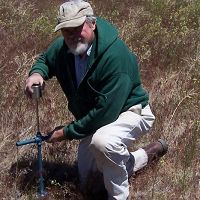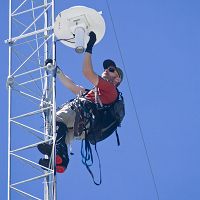Johnson et al., 2009
Nutrient hotspots and O horizon runoff in a Sierra Nevada Watershed.
Johnson, D. W., Miller, W. W., Meadows, M., Rau, B. R. (2009)
Fall meeting, American Geophysical Union, December 2009. 90(52). Abstract EP52B-04.
-
Sierra, INVESTIGATOR
-
Sierra, COLLABORATOR
-
Sierra, STAFF
Abstract
Because of the extremely dry summers, rooting is entirely absent in the O horizons of many forest ecosystems in the eastern Sierra Nevada Mountains of Nevada and California. Thus, decomposition/N mineralization and vegetation uptake processes are spatially discoupled, and the intense competition for N between roots and decomposers in the O horizon which characterizes more humid forest ecosystems is absent. Because of this discoupling, the N returned in littterfall is not recycled to the trees until: 1) N supply exceeds microbial demand, and 2) N is leached to lower horizons where roots are present. Both O horizons and the mineral soil surface in these ecosystems are extremely hydrophobic in summer, restricting the ability of summer rainfall to wet underlying mineral soils except via preferential flowpaths. Recent studies have found very high concentrations of ionic forms of N in O horizon interflow solutions that flow over the top of mineral soils. We hypothesize that this O horizon interflow creates biogeochemical “hot spots” and “hot moments” (Schimel and Bennett, 2004) where it infiltrates into preferential flowpaths present in the mineral soil. This paper reports the initial results of a study aimed at detecting O horizon runoff and nutrient hot spots in soils of the King’s River Experimental Watershed (KREW) in the western Sierra Nevada Mountains of California, one of the Critical Zone Observatory sites. We hypothesized that 1) nutrient rich runoff would occur in the KREW watersheds, as in the eastern Sierra; and 2) this runoff would contribute to the presence of nutrient hotspots on a centimeter scale in the soil. Testing Hypothesis 1) was straightforward: we installed O horizon runoff collectors in the KREW watersheds and found substantial amounts of runoff did occur, but the runoff waters were somewhat less nutrient-rich than in the drier forests of the eastern Sierra Nevada. Testing Hypothesis 2 was less straightforward because the most precise detection of preferential flow hotspots would require destruction of the sampling plots. We opted instead for measuring nutrient variability in small plots (3 x 3 m) using resin samplers in addition to traditional litter and soil sampling. We detected hot spots for ammonium and nitrate in nearly all cases in these plots (as indicated by the presence of extreme outliers), but hotspots for more abundant nutrients such as calcium and magnesium were either non-existent (resin collectors) or very rare (litter leachates). We inferred from nutrient ratios in runoff and in the small plots which hot spots might be due to infiltration from O horizon runoff.
Citation
Johnson, D. W., Miller, W. W., Meadows, M., Rau, B. R. (2009): Nutrient hotspots and O horizon runoff in a Sierra Nevada Watershed . Fall meeting, American Geophysical Union, December 2009. 90(52). Abstract EP52B-04..
Explore Further



